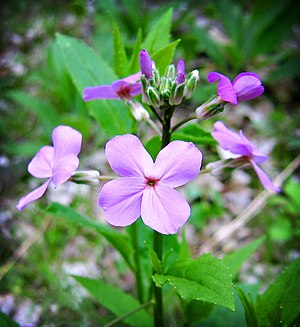Night violets
| Night violets | ||||||||||||
|---|---|---|---|---|---|---|---|---|---|---|---|---|

Common night vole ( hesperis matronalis ) |
||||||||||||
| Systematics | ||||||||||||
|
||||||||||||
| Scientific name | ||||||||||||
| Hesperis | ||||||||||||
| L. |
The night violets ( Hesperis ) or Kilten form a genus in the family of the cruciferous plants (Brassicaceae).
description
Species from the genus of the night violet are annual or perennial herbaceous plants . The stems are simple or branched. The leaves are egg-shaped, lyre-shaped or oval-toothed. The flowers grow in simple or compound umbels . They have four crooked petals and a closed calyx . Glands sit between the two filaments . The scar is forked at the base but reunited towards the tip. The seeds ripen in cylindrical, double-fan, double-lobed pods .
distribution
Night violets are common all over Eurasia . However, some species are also found in North America .
Systematics
In 1753, Carl von Linné placed six species in the genus of the night violet. In the meantime, over 25 species have been included in the genus, but today some of them have been downgraded to subspecies or have been aggregated into collective species.


The types are (here a selection):
- Hesperis dinarica Beck ; it occurs only in Albania, Greece, the former Yugoslavia, Romania and Bulgaria.
- Odorless night viola ( Hesperis inodora L. ); is endemic to the Maritime Alps
- Hesperis kotschyana Fenzl ; it occurs only in Turkey, Syria and Lebanon.
- Slit-leaved Night VIole ( Hesperis laciniata All. ): It occurs in Morocco, Spain, Portugal, France, Italy and on the Balkan Peninsula.
-
Common nocturnal viola also known as red nocturnal viola, matronflower ( Hesperis matronalis L. ); with the subspecies:
- Hesperis matronalis subsp. cladotricha (Borb.) Hayek
- Hesperis matronalis subsp. matronalis : It is originally found in Spain and France, but is a neophyte in many countries around the world.
- Hesperis matronalis subsp. nivea (Baumg.) Kulcz. (Syn .: Hesperis matronalis subsp. Candida (Kit.) Hegi & Em. Schmid ): It occurs in Spain, France, Italy, Austria, Hungary, Poland, Slovenia, Croatia, Serbia, Romania and the Ukraine.
- Hesperis matronalis subsp. schurii Soó
- Hesperis matronalis subsp. voronovii (N. Busch) PW Ball : It occurs in Turkey, Crimea and Georgia.
- Hesperis pendula DC. ; it occurs only in Turkey, Syria, Lebanon, Jordan and Israel.
- Hesperis persica Boiss. ; it occurs only in Iran, Eastern Turkey and Armenia.
- Siberian night violet ( Hesperis sibirica L. ); it occurs only in Central Asia, Siberia, Mongolia and China.
- Hesperis sylvestris Crantz ; it occurs in eastern Central Europe and in Southeastern Europe to the Caucasus.
- Mourning night veil also melancholic night veil ( Hesperis tristis L. )
etymology
Hesperis comes from the ancient Greek hespera (= evening) after the flowers of especially Hesperis matronalis, which are strongly scented in the evening and at night .
Trivia
Johann Mayrhofer dedicated a poem of the same name to the Nachtviolen, which was set to music by his friend Franz Schubert in 1822 ( Nachtviolen D. 752).
literature
- Oskar Sebald, Siegmund Seybold & Georg Philippi (eds.): The fern and flowering plants of Baden-Württemberg , Volume 2: Special part (Spermatophyta, subclass Dilleniidae) Hyperaceae to Primulaceae. Page 207, Ulmer, Stuttgart 1992. ISBN 3-8001-3323-7
- Jaakko Jalas, Juha Suominen: Atlas florae europaeae . Volume 10 Cruciferae (Sisymbrium to Aubrieta). Pages 91-100, Helsinki 1994. ISBN 951-9108-09-2
Individual evidence
- ↑ a b c d e f g h i Hesperis in the Germplasm Resources Information Network (GRIN), USDA , ARS , National Genetic Resources Program. National Germplasm Resources Laboratory, Beltsville, Maryland. Retrieved July 26, 2017.
Web links
- Description in the Flora of China
- Germplasm Resources Information Network (GRIN); Retrieved November 22, 2013.